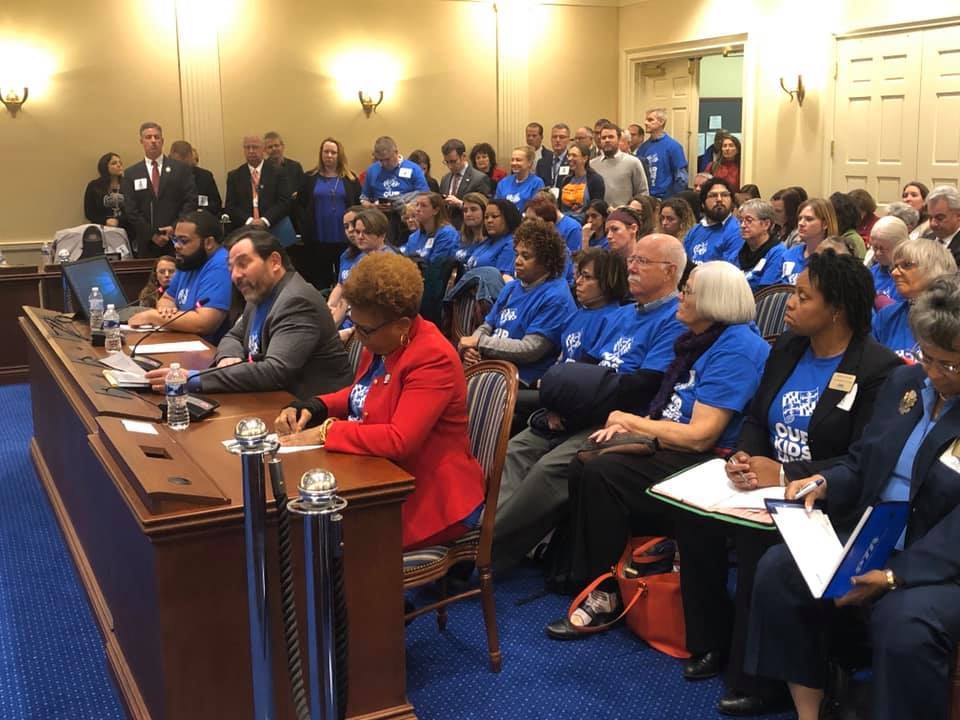
EDITOR’S NOTE: 3/20: The bill has passed through both the General Assembly and the House of Delegates. It now awaits the signature of Governor Larry Hogan.
As discussions ramp up in the Maryland General Assembly surrounding the proposals in the Kirwan Commission—sweeping reforms in the state’s education system based off three years of study—there is a palpable sense of urgency among all those fighting to see it through.
“We have leaders who are ready to act,” says Joe Francaviglia, executive director of Strong Schools Maryland, an education advocacy group in support of the legislation. “It’s a generational moment. This is Maryland’s chance. Either we’re going to seize it, or we’re not.”
The 26-member Kirwan Commission was created by the Maryland General Assembly in 2016 with the purpose of setting a standard for education across the state and preparing students for life beyond the classroom. Its namesake, William E. “Brit” Kirwan—former president of the University of Maryland, College Park and a former chancellor of the University System of Maryland—was appointed by Governor Larry Hogan, the state Senate president, and the state House speaker to lead these efforts.
What resulted was a lengthy report examining the best schools and education systems across the world, which allowed Kirwan and his team to develop several new key ideas to help Maryland become a nationwide education leader. The bill at hand, known as the Blueprint for Maryland’s Future, is purposefully comprehensive, covering issues such as increasing teachers’ salaries to a baseline of $60,000, providing access to Pre-K for all 4-year-olds and 3-year olds in low-income families, and offering career and technical services for impending high school graduates.
The first three years of funding for these proposals was approved last year by the General Assembly. Getting that same approval—and funding—for the next 10 years is what’s currently on the table.
“One of the most exciting things about this whole package is that it is a package,” Francaviglia says. “Often in our state and nation’s history, we’ve tried to find silver bullets to very complex problems, and there are no silver bullets in education. It takes systemic reform. That’s exactly what this is.”
These proposals are crafted in a way that considers how they might work in concert with each other. Essentially, advocates say, one reform’s benefits can’t fully be realized without another. Cheryl Bost, president of the Maryland State Education Association, attended a marathon hearing in Annapolis Monday, where more than 150 business leaders, educators, and advocates testified on the bill’s behalf.
“When students come and they’ve had great Pre-K and kindergarten opportunities, they are really engaged and ready to learn the same as other peers,” says Bost, who has observed this relationship at work as a 4th and 5th grade teacher at Title I East Baltimore elementary school Mars Estates. “We can’t wait another year until we make an investment in our students. This is a once in a generation opportunity for our public schools in Maryland.”
However, much has been discussed as to how exactly a decade-spanning, revolutionary $4 billion annual bill like the Blueprint is to be funded. Baltimore City would have to contribute $340 million more annually, and the total amount of spending to fulfill the program in its full term amounts to around $32 billion. Elected Democratic officials in Baltimore, and the city’s delegation in Annapolis, have expressed their commitment to fully implementing the Kirwan plan—although where the increased city funding will come from remains a question.
The bill has faced opposition from Republican leaders including Governor Larry Hogan, who called the spending proposals “reckless and irresponsible” on Facebook. He has also floated a $6,000 increase in taxes per family figure that he claims the bill would initiate, though critics have said that the variables used to arrive at this figure are questionable.
As for how the bill’s programs could be funded, there are a variety of measures being considered, from legalizing sports betting to increasing the state tobacco tax. Those in support of the legislation feel that no price should be too high to provide world-class education to Maryland’s students.
“It’s disturbing, because we’re talking about children,” says Shamoyia Gardiner, a former educator and the education policy director at Advocates for Children and Youth. “People are so ready to skew the conversation that should be about placing children at the center and focusing it on taxes. If you have childrens’ best interests at heart, then you don’t see a problem and decide that’s the end of the line.”
Throughout this process, there has been little to no opposition for the proposals contained within the bill. Rather, the disconnect is between those who want to make the legislation work at all costs, and those who have concerns about the amount of money it would take to do so.
As for when and if the bill could be passed, that will be up to the General Assembly, whose session runs through April. If the beginnings of conversations around the legislation are any indication, the passion that has engulfed the proceedings isn’t likely to die down anytime soon.
“This is not something where we can just meet halfway,” Francaviglia says. “These are fundamental and moral questions of our time. We have momentum and public opinion on our side, and a legislature who cares deeply. We can’t delay any further.”